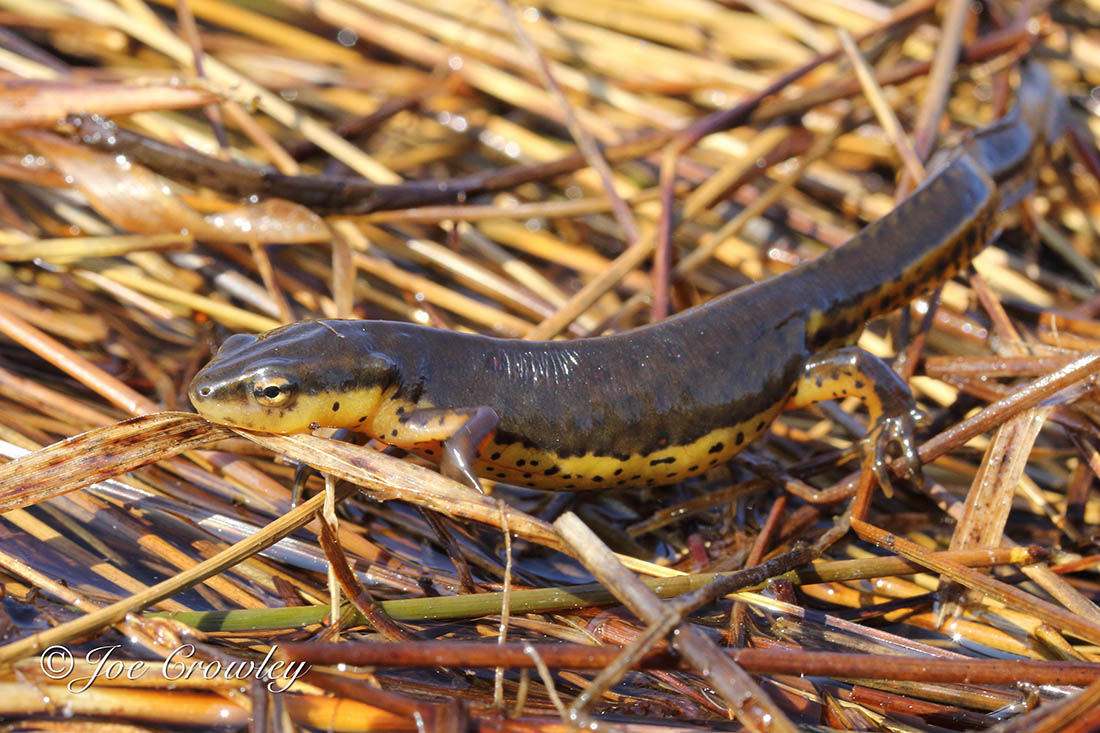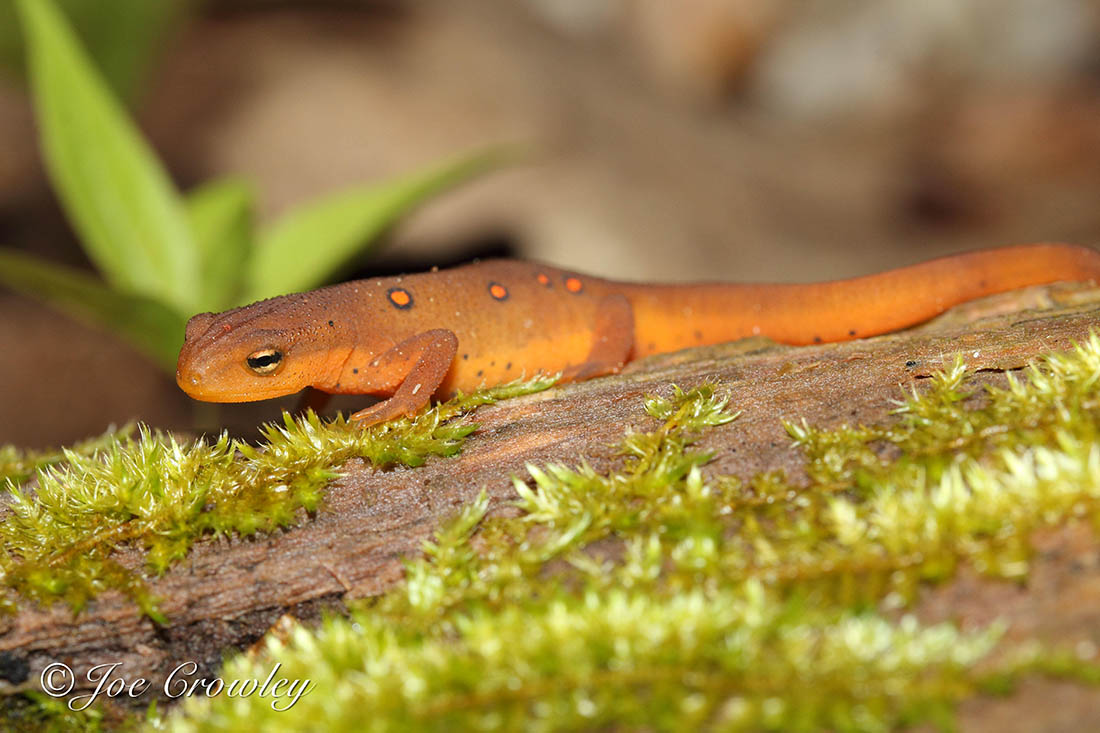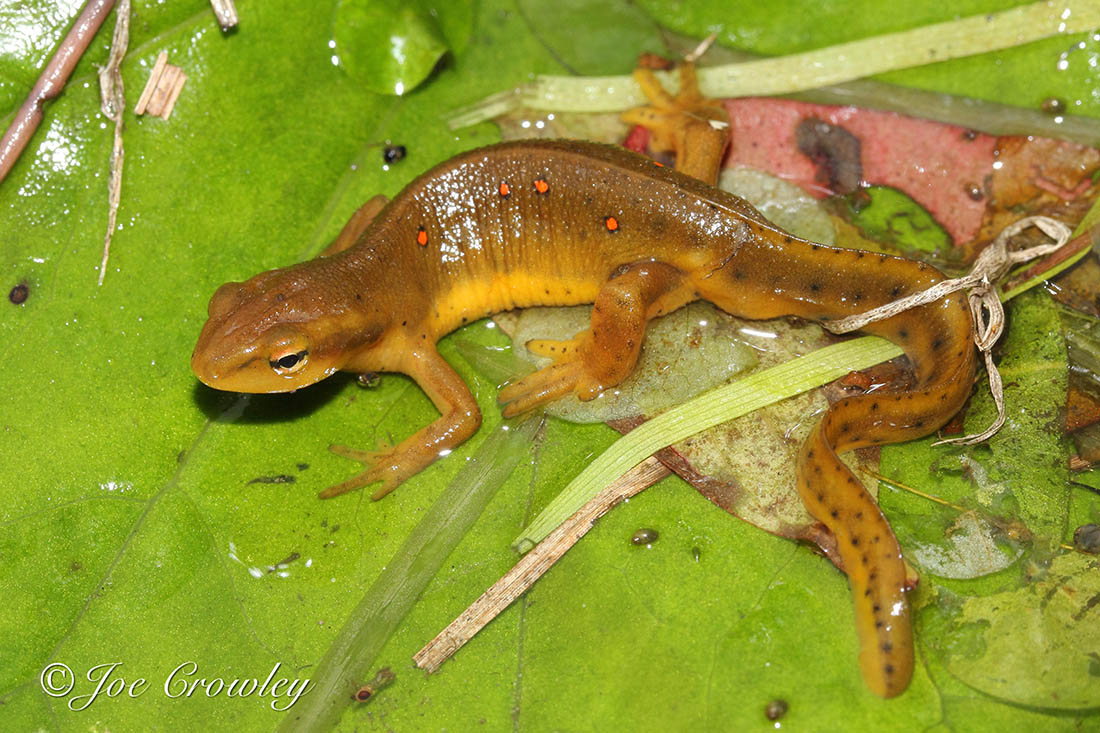The eastern newt (Notophthalmus viridescens) is a colourful salamander native to eastern North America. It has a large geographic range that extends from eastern Canada south throughout most of the eastern United States, making it the second-most widespread salamander species in North America. Four subspecies are recognized across its range, two of which are found in Canada: the red-spotted newt (Notophthalmus viridescens viridescens; PEI, NS, NB, QC, ON) and the central newt (Notophthalmus viridescens louisianensis; ON).

Description
Eastern newts are relatively small salamanders that can grow up to 14 cm in total length. They typically have four life stages: eggs, aquatic larvae with gills, juveniles that develop lungs and live on land (red efts) and aquatic adults with lungs. However, in some populations, individuals may skip the juvenile red eft stage. These individuals do not develop lungs and instead retain gills as adults.
Adults are olive green to yellowish brown on top with a bright yellow underside. Their entire body, limbs and tail are covered with black speckling. They have a dark stripe through each eye. Red-spotted newts have two rows of black-bordered orangish-red spots along their back, while these spots are less pronounced or absent on central newts. Adults have a paddle-like tail that is flattened along the sides with a small keel (a raised ridge) on the top and bottom. In some populations, adults may remain on land after reaching maturity, and these individuals often bear more resemblance to red efts than aquatic adults.
Larvae have feathery external gills, a large tail fin and four legs that develop as they grow. They are tan, yellowish brown or greenish-brown with mottling and dark spots. A dark stripe extends from the snout through each eye, and individuals may have a dark band down their back. Larvae are 7 to 9 mm in length on average when they hatch and grow to more than 4 cm before undergoing metamorphosis.
The juvenile red eft stage is bright reddish-orange to greenish brown in colour with a lighter orange belly. Like adults, they are covered in dark speckling and have a dark stripe through each eye, and the red-spotted subspecies usually has two rows of black-bordered orangish-red spots along their back. Their skin is more granular than in adults, and the tail is less flattened.

Distribution and Habitat
In Canada, the red-spotted newt ranges from Prince Edward Island westward through New Brunswick, Nova Scotia, Southern Quebec and Southern and Central Ontario to the northeastern shore of Lake Superior. The central newt’s Canadian range is restricted to northwestern Ontario west of Thunder Bay. South of the border, the eastern newt has a widespread distribution that extends from Maine south to Florida and westward to Minnesota in the north and Texas in the south.
Eastern newts breed in a variety of aquatic habitats, including wetlands, lakes, slow-flowing streams, ponds and human-modified habitats like ditches and canals. Ideal breeding habitats are typically in or near forested areas and have an abundance of aquatic vegetation. Most adults live in these aquatic habitats year-round. However, in some populations, adults may disperse into the surrounding forests and adopt a terrestrial lifestyle. The red efts live in the forest understory and may travel considerable distances over land. In one population, red efts were documented to move an average of 800 m away from their aquatic habitat. Terrestrial individuals depend on leaf litter, logs, stumps and other cover on the forest floor to provide cool, moist conditions and protection from predators. Aquatic adults typically spend the winter underwater, while red efts and terrestrial adults hibernate in mammal burrows, root cavities and other underground spaces where they can get below the frost line.
(map by The Canadian Encyclopedia, data courtesy the International Union for the Conservation of Nature Red List Data, Version 2024-1)
Reproduction and Development
Eastern newts breed during the fall and spring. After courting the female, the male deposits a spermatophore (sperm packet), which the female picks up with her cloaca (a single opening at the base of the tail for the digestive, urinary and reproductive tracts). Eggs are laid in the spring. Females lay 80–450 eggs, which are attached singly to sticks, aquatic vegetation or other structures in the water. The eggs hatch after three to five weeks. The larvae are aquatic and breathe through gills. Larvae typically undergo metamorphosis in two to five months, transforming into juvenile red efts. The red efts, which have lungs and breathe air, disperse into the surrounding forest. After one to seven years, the red efts reach maturity and migrate back to aquatic habitats, where they will begin breeding as adults. However, in some populations, individuals do not undergo metamorphosis into red efts. Instead, they transform directly into gilled adults. These individuals may reach sexual maturity in less than one year. Eastern newts are relatively long-lived, with individuals capable of living up to 15 years in some populations.
Did you know?
Eastern newts have elaborate courtship behaviour. When courting a female, the male may perform a short dance called a “hula.” If the female follows and nudges his tail, he will drop a spermatophore for her to pick up. Alternatively, the male may engage in more complex courtship behaviour. In this case, the male grasps the female behind her head with his hind legs, rubs her snout with his face and front legs and wafts cloacal secretions toward her face with his tail. After a prolonged period that may last more than an hour, the male begins making rapid swimming motions before eventually dismounting and moving in front of her, hoping the female will follow and request a spermatophore by nudging his tail.
Diet and Predation
All life stages of the eastern newt are carnivorous. Aquatic adults eat a variety of other animals, including insects and their larvae, worms, leeches, molluscs, crustaceans, small fish and other amphibians, including eggs and tadpoles. Red efts and terrestrial adults forage on the forest floor for invertebrates, including insects, spiders and mites. Larvae eat aquatic invertebrates, such as insects and their larvae, protozoans (single-celled organisms), small crustaceans (e.g., water fleas) and molluscs.
Eastern newts produce toxic skin secretions that are unpalatable to most species. These toxins can cause serious sickness or death if consumed by predators. The eastern newt’s bright colouration is aposematic, which warns potential predators of their toxicity. When confronted by potential predators, newts often assume a defensive posture by raising their heads and curling their tails, which shows off their brightly coloured undersides. Despite their toxicity, they are still preyed upon by some predators, such as snapping turtles, painted turtles, bullfrogs and some insects.

Status and Threats
Globally, the eastern newt is listed as Least Concern by the International Union for Conservation of Nature. This species is widespread and abundant in Canada, and its status has not been assessed by the Committee on the Status of Endangered Wildlife in Canada. Eastern newts can occur in high densities in some areas, and red efts can sometimes be seen in the thousands during their spring and fall migrations. Threats to this species include habitat loss, road mortality, intensive forestry practices (e.g. clear-cutting) and chemical pollution (e.g. pesticides, fertilizers, industrial chemicals and road salt).


 Share on Facebook
Share on Facebook Share on X
Share on X Share by Email
Share by Email Share on Google Classroom
Share on Google Classroom




